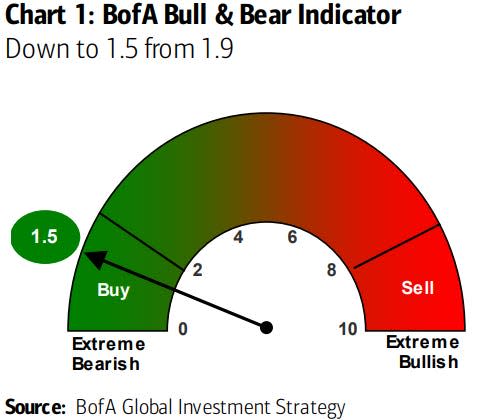A flurry of buy and sell signals is sending mixed messages as to where the stock market goes from here.
The confusion comes as investors continue to debate when a recession will hit the economy.
Here’s a round up of the buy and sell signals that have flashed in the stock market over the past month.
The stock market is sending mixed messages to investors after a flurry of buy and sell signals flashed over the past month.
Investors are trying to gauge where the stock market goes from here after the S&P 500 fell 10% from its late-July high. While the index is still up about 8% year-to-date, that’s less than half of its 20% year-to-date gain seen just a few months ago.
Top of mind for investors is whether a year-end rally for the stock market materializes due to favorable seasonality data, or if an economic recession is right around the corner.
Because the stock market is a leading indicator of the broader economy, investors are looking for signals from the market to better gauge what lies ahead.
Here’s a round up of the buy and sell signals that have flashed in the stock market over the past month, sending mixed messages to investors.
Sell: The S&P 500 fell below its 200-day moving average
The S&P 500 closed below its 200-day moving average two weeks in a row on Friday, violating a key technical support level that trend-followers use to help determine the stock market’s overall direction.
Some traders use this signal as a reason to sell stocks, including billionaire investor Paul Tudor Jones.
“My metric for everything I look at is the 200-day moving average of closing prices. I’ve seen too many things go to zero, stocks and commodities. The whole trick in investing is: ‘How do I keep from losing everything?’ If you use the 200-day moving average rule, then you get out. You play defense, and you get out,” Paul Tudor Jones said in 2014.

Buy: BofA’s Bull & Bear Indicator falls into “Buy” territory
Bank of America’s Bull & Bear Indicator dropped to 1.5 this week out of 10, representing its lowest level since November 2022 and flashing a “Buy” signal for stocks. The decline in the indicator has been driven by outflows from high-yield bonds and global stocks, as well as a deteriorating picture of global equity breadth.
This contrarian indicator has been pretty reliable over time. Since 2002, there have been 20 buy signal occurrences, with the median three-month return after the signal flashed being 5.4% for US stocks and 7.6% for global stocks, according to Bank of America.

Sell: Dow Theory confirms recent breakdown in stocks
Dow Theory flashed a “Sell” signal on Monday after the Dow Jones Industrial Average closed below its early-October lows, Manuel Blay, editor of TheDowTheory.com told Insider. The decline came a couple days after a breakdown in the Dow Jones Transportation Average.
What’s concerning is that since the sell signal was confirmed, transportation stocks have continued to fall, which is does not bode well for the broader stock market.
Transportation stocks are viewed as a leading indicator for both the stock market and economy, as these companies are tasked with moving goods and people across the country, which is vital to ongoing economic growth. If companies are seeing a slowdown in growth and their stock prices fall, it could be a grim warning for the rest of the economy and stock market.
Buy: Investor’s allocation to cash hit extreme levels
A recent survey from Bank of America showed that cash allocations among professional investors jumped above the 5% threshold. That triggers a contrarian buy signal for stocks, according to the bank, and it has historically preceded solid gains ahead.
“Since 2011, the ‘buy’ signals would have seen S&P 500 returns of 2% in the two months after, 4% in the three months later, [and] 7% in the six months after,” Bank of America said earlier this month.

Sell: The VIX jumped above 20
The volatility index, commonly referred to as the stock market’s fear gauge, jumped above the psychologically important 20 level this week. A VIX reading above 20 indicates a high-volatility environment for the stock market and is commonly seen during bear market declines.

Buy: Long-term growth expectations spark “Buy” signal
Long-term profit growth expectations among Wall Street analysts fell to near record low levels last month, which signals pervasive pessimism, according to Bank of America. Typically, when there’s such a high level of pessimism towards future corporate profits, the stock market delivers spectacular returns.
“Today’s Long-Term Growth [expectations] suggests >25% price returns over the next 12 months for the S&P 500,” Bank of America’s Savita Subramanian said last month.
Read the original article on Business Insider
Credit: Source link




